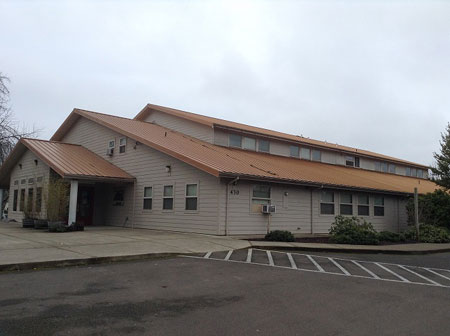

 2017 J-LEAP Report
2017 J-LEAP ReportSheridan Japanese School
Sheridan, OR
Konnichwa. My name is Keiko Suzuki. I am currently teaching Japanese as an assistant at Sheridan Japanese School in Oregon. I once taught Japanese at a high school in Thailand for 2 years. This is my first time to America and I’ve been here for about 5 months. In this article, I’d like to share my inspiring experience and how I’ve felt through my life here teaching in America.
My school
Sheridan Japanese School (SJS), where I have been assigned, is a public charter school founded by parents and teachers. Since the school limits the number of the students, there are only 88 students from 4th to 12th grade with 10 teachers and staff members. Surprisingly, almost all the students learn Japanese as a required subject. In Japanese class, the students are divided into 5 classes by proficiency-level rather than grade level. SJS not only offers Japanese language class, but also adopts Japanese school culture in daily life. For example, students change from outdoor to indoor shoes when they enter the school, clean the school by themselves and call every teacher “Sensei (teacher in Japanese)”. What is more, all classrooms have names which came from the islands and seas in Japan such as “Honshu(the main island)” and “Setonaikai(Seto island sea).” In addition, we do radio exercise every day in the morning! As a Japanese person, I really appreciate that students learn Japanese almost every day and cherish our culture. In these ways, SJS is a small and unique school.

My work
My lead teacher, Davis-sensei and I teach Japanese together in 3 classes. I believe that team-teaching makes it possible to offer a better class to students because the American teacher and Japanese teacher can utilize their strengths and make up for each other’sweaknesses. Though we are still searching for the best way to team-teaching, I have learned a lot from the way Davis-sensei teaches Japanese. In class, it seems like she tries to let them hear natural and understandable Japanese as much as possible and this make our classroom comfortable for students to speak Japanese. As I haven’t focused on those points so much personally, I was impressed with that and her passion toward Japanese education as well. I’ll keep doing my best to be able to give something meaningful to Davis-sensei, and to the students.
I’m also teaching small group of 5 students alone. I’m very lucky to have a variety of experiences to teach students of varying ages, in small to large classes, by team-teaching and solo-teaching here.
Also, I’m in charge of a Japanese culture class once a week. In this class, I’ve introduced Japanese culture such as making onigiri, making seasonal decorations with origami and looking back on the history of radio exercise. I’d like them to enjoy the differences between our cultures as well as to understand the spirit behind Japanese culture.
Students and teachers at SJS
Compared with Japanese and Thai students, I have the impression that American students have a lot of freedom, which is very interesting to me. For example, they can dye their hair green or pink, they can wear hats in the classroom and they can participate in class while sitting on the classroom couch if they get permission from the teacher. I feel students are respected as individuals. Also, students are very honest during class. I can tell if today’s lesson was successful or not when I see the students’ faces. It is my greatest joy as a Japanese teacher to see students enjoy talking in Japanese with the expressions I taught them that day.
Also, I love the teachers at SJS. They don’t just teach their subject, but they also support students in respect to each student’s situations and problems they may be facing. They always think what is best for students and carry out plans to help them. Since SJS is such a small school, teachers and students are like one family. They show me how a teacher should be and I’m happy to work together with them.
My homestay life
I enjoy my free time outside of school too. Having unfamiliar foods is one of my pleasures here, such as artichoke, eggnog pie and lentil soup. All of them were cooked by my host mother and were very tasty. Also, I like talking with my host family. They have told me about American culture and history, which is very intriguing. I look forward to dinner time with my host family every day.
Lastly, I’d like to say thank you to those who have accepted me warmly here in America despite being busy, my family and friends who always support me from Japan, the teachers who look over me with kind eyes and my dependable friends who came to America together. Thanks to everyone, I can be here and work with great people at SJS. I’ll try to make progress one day at a time, asking myself what is the best for the students again and again.